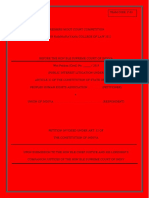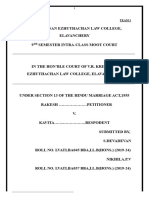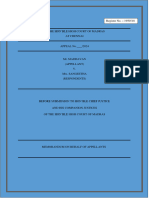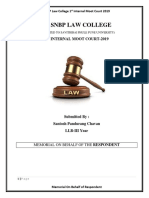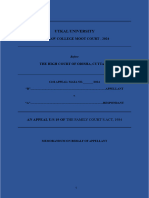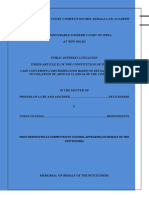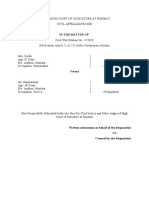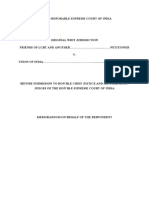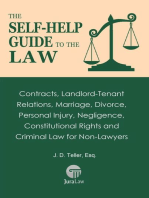St. Wilfred College of Law, Jaipur Moot Court Competition: 1 - Memorandum On The Behalf of Respondent
St. Wilfred College of Law, Jaipur Moot Court Competition: 1 - Memorandum On The Behalf of Respondent
Uploaded by
Rabby NawabCopyright:
Available Formats
St. Wilfred College of Law, Jaipur Moot Court Competition: 1 - Memorandum On The Behalf of Respondent
St. Wilfred College of Law, Jaipur Moot Court Competition: 1 - Memorandum On The Behalf of Respondent
Uploaded by
Rabby NawabOriginal Title
Copyright
Available Formats
Share this document
Did you find this document useful?
Is this content inappropriate?
Copyright:
Available Formats
St. Wilfred College of Law, Jaipur Moot Court Competition: 1 - Memorandum On The Behalf of Respondent
St. Wilfred College of Law, Jaipur Moot Court Competition: 1 - Memorandum On The Behalf of Respondent
Uploaded by
Rabby NawabCopyright:
Available Formats
ST.
WILFRED COLLEGE OF LAW, JAIPUR MOOT COURT COMPETITION
TABLE OF CONTENTS
Table of contents …………………………………………….2
Index of Authority…………………………………………….3
Cases cited…………………………………………….3
Statutes referred………………………………………3
Websites……………………………………………….4
Law reports…………………………………………….4
List of Abbreviations………………………………………….5
Statement of Jurisdiction………………………………………6
Statement of facts………………………………………………7
Issue Raised ……………………………………………………9
Summary of Issues. …………………………………………….10
Arguments Advance ……………………………………………… 11-22
ISSUE 1: - WHETHER THE LIVE-IN-RELATIONSHIP IS LEGAL/VALID?
….11
[A] THE PEVIEW OF THE LEGALITY OF THE CAPACITY OF THE LEGAL LIVE-
IN-RELATIONSHIP
[B] THE LIVING STATUS AMONST THE PETITONER AND THE RESPONDENT
[C] THE PARAMETERS BY THE APEX COURT
ISSUE 2: WHETHER THE CASE IS MAINTAINBLE UNDER SECTON 125
OF THE CRIMINAL PROCEDURE CODE 1973?...............................................14
[A] THE INTERPRETATION OF THE LEGISLATION OF SECTION 125 OF THE
CODE
[B] APPLICATION OF THE LEGISLATION
[C] SUBJECTMATTER OF THE LEGISLATION
ISSUE 3: WHETHER THE CHILD IS A LEGITIMATE ONE?....................20
[A] BENEFITS DENID BY THE NON BIOLOGICAL CHILD, IF LEGITIMATE OR
ILLEGITIMATE
Prayer……………………………………23
1|Page MEMORANDUM ON THE BEHALF OF RESPONDENT
ST. WILFRED COLLEGE OF LAW, JAIPUR MOOT COURT COMPETITION
INDEX OF AUTHORITIES
CASES CITED
CASES PAGE
NO.
11
Lata Singh v. State of U.P. (2006) SC 682
Indira Sharma v. V.K.V. Sharma (2013) 15 SCC 755 11
D. Veluswamy v. D. Patchiammal (2010) 10 SCC 469 (acse no. 2028-2029 of 13
2010)
Savitaben Somabhai Bhatiya v. State of Gujarat 17
Bajirao Raghoba Tambore v. Tolanbai Bhagwan Tonge &, 1980 Cr. LJ 473 17
(BOM)
Smt. Yamuna Bai Anantrao Adhan v. Anantrao Shivam Adhan 1983 Cr.LJ 259 18
(BOM)
Pherari Singh v. State of U.P. ,1990 Cr.LJ 884 =1989 ALI 667 18
Shahzadi Begum v. Mohd. Abdul Gaffar, 1981 Cr.LJ 1532 18
Madhab Pradhan v. Ketaki Pradhan, 1995 Cr,LJ 1785 ORRISA 18
Captain Ramesh Chandra Kaushal v. Veena Kaushal & ors. AIR 1978 SC 180 19
K. Vimla v. K. Veeraswamy AIR 1991 SCR (1) 904 19
S.P.S Balasubramanyam v. Suruttayan 1994 AIR 133, 1994 SCC (1) 460
2|Page MEMORANDUM ON THE BEHALF OF RESPONDENT
ST. WILFRED COLLEGE OF LAW, JAIPUR MOOT COURT COMPETITION
Revanasiddappa v. mallikarjun 2011 SCC 540
Dimple Gupta v. Rajiv Gupta 2002 Cri LJ 493, II 2002 DMC 1
Vidyadhasi v. Sukhrana Bai 2008 SCC,50
STATUTE REFERRED
The Criminal Procedure Code, 1973
The Indian Evident Act, 1872
The Protection of Women Against Domestic Violence Act, 2005
The Constitution of India, 1950
WEBSITES REFERRED
https://legislative.gov.in/sites/default/files/A1872-01.pdf
https://legislative.gov.in/sites/default/files/A1974-02.pdf
https://legislative.gov.in/constitution-of-india
https://www.indiacode.nic.in/bitstream/123456789/15436/1/
protection_of_women_from_domestic_violence_act%2C_2005.pdf
COMMITTEE REPORT
The Law Report of Mali math Committee 2003
3|Page MEMORANDUM ON THE BEHALF OF RESPONDENT
ST. WILFRED COLLEGE OF LAW, JAIPUR MOOT COURT COMPETITION
LIST OF ABBREVATIONS
ABBREVATIONS FULL FORM
v. Versus
S.C. Supreme Court
H.C. High Court
SCC Supreme Court Cases
AIR All India Reports
PWDVA Protection of Women Against Domestic
Violence Act
Cr.PC Criminal Procedure Code
IEA Indian Evident Act
SCR Securities Contract Regulations
HCC Humanitarian Law Commission
A.C Assistant Commissioner
P.C Privy Council
Ors. Others
Anr. Another
Hon’ble Honorable
& And
u/s Under section
Art. Article
Gov. Government
C.O.I. Constitution of India
4|Page MEMORANDUM ON THE BEHALF OF RESPONDENT
ST. WILFRED COLLEGE OF LAW, JAIPUR MOOT COURT COMPETITION
Enc. Enacted
i.e. That is
5|Page MEMORANDUM ON THE BEHALF OF RESPONDENT
ST. WILFRED COLLEGE OF LAW, JAIPUR MOOT COURT COMPETITION
STATEMENT OF JURISDICTION
THE HON'BLE SUPREME COURT OF JUDICATURE AT DELHI EXERCISES
JURISDICTION TO HEAR AND ADJUDICATE OVER THE MATTER UNDER
ARTICLE 136 (1) OF THE CONSTITUTION OF INDIA. THE PETITIONER HUMBLY
SUBMITS TO JURISDICTION OF THE HON'BLE COURT WHICH HAS BEEN
INVOKED BY THE RESPONDENT. HOWEVER, THE PETITIONER RESERVES THE
RIGHT TO CHALLENGE THE SAME. THE PROVISION UNDER WHICH THE
PETITIONER HAS APPROACHED THE HONORABLE COURT IS READ HEREIN
UNDER AS:
“136(1). Appellate jurisdiction of Supreme Court in regard to criminal matters
(1) An appeal shall lie to the Supreme Court from any judgment, final order or
sentence in a criminal proceeding of a High Court in the territory of India if the High
Court has on appeal reversed an order of acquittal of an accused person and
sentenced him to death; or has withdrawn for trial before itself any case from any
court subordinate to its authority and has in such trial convicted the accused person
and sentenced him to death.”
6|Page MEMORANDUM ON THE BEHALF OF RESPONDENT
ST. WILFRED COLLEGE OF LAW, JAIPUR MOOT COURT COMPETITION
STATEMENT OF FACTS
BACKGROUND OF THE CASE:
I. Sufiyah was Muslim girl and was 2nd year Economics (Hons) students, also Anirudh
was a Hindu Boy and was final year student. In the year 2020 they both were studying
in commerce government college Jaipur.
II. In Annual function they developed intimacy and they fell in love with each other.
III. Due to the reason of different religions the families of both the parties were
dissatisfied with their relationship. One day they escaped from college and start’s
living in a rented house in a remote village of Kota.
IV. Respondent was working as HR manager and was the only earning source for the
maintenance of their livelihood.
LINKUP OF RADHIKA AND ANIRUDH:
V. Respondent’s father was a rich man and was dissatisfied with the live in relationship
between the Petitioner and Respondent.
VI. His father arranged a marriage proposal with another girl named Radhika. His father
called him to visit home as his mother was not well.
VII. Radhika belongs to well renowned family, along with her parents she was invited on
the same day to his house for the ring ceremony.
VIII. Being captivated by the beauty of Radhika and family pressure, Respondent agreed to
marry Radhika. This fact was not known to the petitioner.
IX. Respondent married to Radhika on 8 Nov 2021.
DISPUTE BETWEEN PETITIONER AND RESPONDENT:
X. Respondent left Petitioner saying that he has got a good job at Udaipur. After
Arrangement he will take along with him said before his marriage.
XI. Thereafter, Respondent regularly neglected petitioner. But afterwards the Petitioner
came to know about their marriage. Most of the time hatred arguments and hot words
were exchanged between them.
XII. During the time, Petitioner delivered a girl child on 22 August 2022.
XIII. Respondent drove her away with the allegation that the child born from Petitioner is
an illegitimate one.
7|Page MEMORANDUM ON THE BEHALF OF RESPONDENT
ST. WILFRED COLLEGE OF LAW, JAIPUR MOOT COURT COMPETITION
XIV. Respondent came that there was no marriage solemnized between them so he
reluctant to accept the child.
JUDICIAL TREATMENT:
PETITION IN THE SUPREME COURT
XV. Petitioner took shelter of the court and filed a maintenance case under section 125 of
Criminal Procedure Code, for herself and her child.
XVI. Respondent stated that he is not liable to pay the maintenance to the Petitioner and
also to her child.
XVII. Application rejected by the trial court.
XVIII. The matter before the Hon’ble Supreme court is stated that the Petitioner has filed a
Special Leave Petition against the order passed by the trial court.
8|Page MEMORANDUM ON THE BEHALF OF RESPONDENT
ST. WILFRED COLLEGE OF LAW, JAIPUR MOOT COURT COMPETITION
STATEMENT OF ISSUES
______________ISSUE 1_______________
WHETHER THE LIVE-IN RELATIONSHIP IS LEGAL/VALID?
_______________ISSUE 2________________
WHETHER THE CASE IS MAINTAINABLE U/S 125 OF CRPC?
_________________ISSUE 3__________________
WHETHER THE CHILD IS A LEGITIMATE ONE?
9|Page MEMORANDUM ON THE BEHALF OF RESPONDENT
ST. WILFRED COLLEGE OF LAW, JAIPUR MOOT COURT COMPETITION
SUMMARY OF ISSUES
ISSUE 1: - WHETHER THE LIVE IN RELATIONSHIP IS LEGAL/VALID?
The counsel of the behalf of Respondent in the present matter of Sufiyah v. Anirudh, most
humbly submits that the live-in relationship in India is legal/ valid under the legislation. The
respondent is not denying the question of legality of live in relationship but it is contended
that the respondent was into the capacity of the live in relationship with the petitioner. The
respondent has framed the valid reasonability for the parameters established by the Apex
Court with the true and transparent knowledge.
ISSUE 2: - WHETHER THE CASE IS MAINTAINABLE UNDER SECTION 125 OF
CRIMINAL PROCEDURE CODE 1973?
The counsel of the behalf of Respondent (herein after appellant) most humbly submits that
the maintainability for the claim of maintenance mode under section 125 of the criminal
procedure code 1973 is cannot be claimed. There is reasonability that the petitioner does not
falls in the ambit of the meaning of the wife in the meaning of the word “wife” under the
section 125 CrPC (Code of Criminal Procedure). The petitoner cannot acquire the status of
wife within the "meaning of wife" in the section 125 Cr.PC, 1973. The Petitioner cannot also
claim the maintenance for the child born out of the respondent that whether legitimate or
illegitimate cannot be awarded due to the particular reason of not being the biological father
of the girl child.
ISSUE 3. WHETHER THE CHILD IS A LEGITIMATE ONE?
The counsel on the behalf of Petitioner (herein after appellant) put forth that an illegitimate
child who is born out of an illicit relationship is entitled to the maintenance under section 125
of the Cr.PC (Code of Criminal Procedure, 1973). The child is never born out of the
relationship between the respondent and petitioner is presumed to be not the biological kid
of the respondent.
10 | P a g e MEMORANDUM ON THE BEHALF OF RESPONDENT
ST. WILFRED COLLEGE OF LAW, JAIPUR MOOT COURT COMPETITION
ARGUMENTS ADVANCED
ISSUE 1: - WHETHER THE LIVE IN RELATIONSHIP IS LEGAL/VALID?
It is humbly submitted before the Honorable Supreme Court that in the present matter of
Sufiya v. Anirudh, the counsel on behalf of the Respondent put forth that the live-in
relationship in India is legal. It is humbly submitted before the honorable Supreme court that
in the present matter of Sofiya v. Anirudh, the counsel on behalf of the respondent that is Mr.
Anirudh would like to state that there was no live-in relationship between the respondent and
the petitioner.
In the case of Lata Singh v. State of Uttar Pradesh1, the Supreme Court ruled that, although
live in relationships are considered unethical they are not illegal under the Legislation.
In the matter of Indira Sharma v. V.K.V. Sharma 2013 15 SCC 755, the Supreme Court
established certain guidelines to decide whether or not a relationship is ‘in the nature of
marriage’ under Section 2(f) of the Protection of Women from Domestic Violence Act, 2005,
mentioned as under:
1.1 Duration of period of Relationship: Section 2(f) of the PWDV Act has used the
expression “at any point of time”, which means a reasonable period of time to maintain
and continue the relationship which may vary from case to case, depending upon the
facts.
“domestic relationship” means a relationship between two persons who live
or have, at any point of time, lived together in a shared household, when they
are related by consanguinity, marriage, or through a relationship in the
nature of marriage, adoption or are family members living together as a joint
family.
1.2 Shared Household: the expression has been defined under Section 2(s) of the PWDV
Act.
“shared household” means a household where the person aggrieved lives or at
any stage has lived in a domestic relationship either singly or along with the
respondent and includes such a household whether owned or tenanted either jointly
by the aggrieved person and the respondent, or owned or tenanted by either of them
in respect of which either the aggrieved person or the respondent or both jointly or
singly have any right, title, interest or equity and includes such a household which
1
Lata Singh v State of Uttar Pradesh & Anr AIR 2006 SC 2301
11 | P a g e MEMORANDUM ON THE BEHALF OF RESPONDENT
ST. WILFRED COLLEGE OF LAW, JAIPUR MOOT COURT COMPETITION
may belong to the joint family of which the respondent is a member, irrespective of
whether the respondent or the aggrieved person has any right, title or interest in the
shared household;
1.3 Pooling of resources and financial arrangements: supporting each other, or any
one of them, financially, sharing bank accounts, acquiring immovable properties in
joint names or in the name of the woman, long term investments in business, shares
in separate and joint names, so as to have a long standing relationship, may be a
guiding factor.
1.4 Domestic Arrangements: Entrusting the responsibility, especially on the woman to
run the home, do the househ0old activities like cleaning, cooking, maintaining, etc.
is an indication of a relationship in the nature of marriage.
1.5 Sexual relationship: Marriage-like relationship refers to sexual relationship, not
just for pleasure, but for emotional and intimate relationship, for procreation of
children, so as to give emotional support, companionship and also material
affection, caring, etc.
1.6 Children: Having children is a strong indication of a relationship in the nature of
marriage. The parties, therefore, intend to have a long standing relationship.
Sharing the responsibility for bringing up and supporting them is also a strong
indication.
1.7 Socialization in Public: Holding out to the public and socializing with friends,
relations and others as if they are husband and wife is a strong circumstance to hold
the relationship is in the nature of the marriage.
1.8 Intention and conduct of parties: Common intention of the parties as to what their
relationship is to be and to involve, and as to their respective roles and
responsibilities, primarily determines the nature of that relationship. Intention may
be expressed or implied and what is relevant is their intention as to matters that are
characteristics of a marriage.
And herein, in the context of the parameter 1.1 in response of the Petition filed against the
Respondent, the counsel put forth that the expression used here “reasonable period of time”
is not being fulfilled and they have not lived together for a reasonable period of time and so it
is submited that this does not fall under the ambit of the live-in relationship.
12 | P a g e MEMORANDUM ON THE BEHALF OF RESPONDENT
ST. WILFRED COLLEGE OF LAW, JAIPUR MOOT COURT COMPETITION
The parameter 1.2 states Herein, the counsel on behalf of the Respondent presents that the
petitioner and the respondent did not shared household for a considerable period of time. It
was more of walk-in and walk out kind of a relationship. In the matter the parties were living
together since 2020 and it cannot be strongly presumed that span of more than one year can
be the reasonable period of time.
In the context of parameter 1.3 The counsel would like to present that although the financial
arrangements were done by the Respondent, but there was no social or any legal liability of
the Respondent to stay in this live-in relationship. Although, the counsel puts forward that
mere facts that one or less than one-year relationship does not fall under the ambit of live-in
relationship as it would not have considered to be the reasonable period of time for a live-in-
relationship.
In D, Veluswamy v. D. Patchaimmal2 the Apex Court held that the view that not mere
providing for financial assistance will lead a relationship to be a live-in relationship.
Relevancy of the parameter 1.4 Herein on behalf of the Respondent the counsel would like to
put forward that although the household chorus was performed by the Petitioner by her
discretion and that there was not any social or any legal obligation to perform this.
The counsel on behalf of the Respondent observed in the parameter 1.5 that although there
was a sexual relationship between the Respondent and the Petitioner but the counsel would
like to put forward that there was a consent of both the parties involved. There are various
Supreme Court Judgment has said that not all sexual relationship would fall under the ambit
of live-in relationship.
The Law report of Malimath Committee 2003 carried an object of the
“The objectionable conditions are if they are living for the period of a week, a
month, a couple of months, one-night stand many relationships at a time, only for the
sexual design which does not show sincerity in the relationship.”
The reasonable period of the valid relationship is the mere issue for the concern but as the
respondent and the petitioner was more in the walk in &walk out relationship. Due to the
particular gathered in the parameters.
For the parameter 1.6 the counsel in response Put Forth that the child is not the biological
child of the respondent as it was never conveyed to him after the conceiving the baby. The
objection is raised for the purpose of maintenance.
In the present matter it can be observed from the parameter 1.7 that the couple was although
residing together but they were not socializing, in the sense, that they were not being visited
2
D, Veluswamy v. D. Patchaimmal (2010) 10 SCC 469
13 | P a g e MEMORANDUM ON THE BEHALF OF RESPONDENT
ST. WILFRED COLLEGE OF LAW, JAIPUR MOOT COURT COMPETITION
by their friends or relatives. They were not residing their as married couple but were residing
together with their own consent and not due to any influence or so.
Herein the counsel states for the parameter 1.8 that it is put forth on behalf of the Respondent
that the Respondent did not have any intention of marrying the Petitioner and that he did not
make any promise of marrying her in future also. Although the party resided together in the
village of Kota but it cannot be presumed that they were planning any future together.
The counsel highlights that the Parameters established by the Hon’ble Supreme Court is the
Supreme Provisions for the demonstrative a non- legal live-in–relationship as the relationship
was more likely of walk in &walk out nature. Also the counsel submitted the humble
submissions and evince that the grounds are validly to the true knowledge of the Guidelines
provided the Court for the legal live-in-relationship.
ISSUE 2: - WHETHER THE CASE IS MAINTAINABLE UNDER SECTION 125 OF
CRIMINAL PROCEDURE CODE 1973?
At the outset, it is submitted to the Hon’ble Supreme Court that the petitioner is not entitled
for the claim of maintenance under section 125 CrPC as the section states that:
“section 125 of CrPC Order for maintenance of wives, children and parents. — (1)
If any person having sufficient means neglects or refuses to maintain—
(a) his wife, unable to maintain herself, or
(b) his legitimate or illegitimate minor child, whether married or not, unable
to maintain itself, or
(c) his legitimate or illegitimate child (not being a married daughter) who
has attained majority, where such child is, by reason of any physical or
mental abnormality or injury unable to maintain itself, or
(d) his father or mother, unable to maintain himself or herself.
a Magistrate of the first class may, upon proof of such neglect or refusal, order such
person to make a monthly allowance for the maintenance of his wife or such child,
father or mother, at such monthly rate 1 * * * as such Magistrate thinks fit and to pay
the same to such person as the Magistrate may from time to time direct:
14 | P a g e MEMORANDUM ON THE BEHALF OF RESPONDENT
ST. WILFRED COLLEGE OF LAW, JAIPUR MOOT COURT COMPETITION
Provided that the Magistrate may order the father of a minor female child referred to
in clause (b) to make such allowance, until she attains her majority, if the Magistrate
is satisfied that the husband of such minor female child, if married, is not possessed
of sufficient means:
[Provided further that the Magistrate may, during the pendency of the proceeding
regarding monthly allowance for the maintenance under this sub-section, order such
person to make a monthly allowance for the interim maintenance of his wife or such
child, father or mother, and the expenses of such proceeding which the Magistrate
considers reasonable, and to pay the same to such person as the Magistrate may
from time to time direct: Provided also that an application for the monthly allowance
for the interim maintenance and expenses of proceeding under the second proviso
shall, as far as possible, be disposed of within sixty days from the date of the service
of notice of the application to such person.]
Explanation. —For the purposes of this Chapter, —
(a) “minor” means a person who, under the provisions of the Indian Majority Act,
1875 (9 of 1875) is deemed not to have attained his majority;
(b) “wife” includes a woman who has been divorced by, or has obtained a divorce
from, her husband and has not remarried.
[(2) Any such allowance for the maintenance or interim maintenance and expenses of
proceeding shall be payable from the date of the order, or, if so ordered, from the
date of the application for maintenance or interim maintenance and expenses of
proceeding, as the case may be.]
(3) If any person so ordered fails without sufficient cause to comply with the order,
any such Magistrate may, for every breach of the order, issued a warrant for levying
the amount due in the manner provided for levying fines, and may sentence such
person, for the whole or any part of each month’s 4 [allowance for the maintenance
or the interim maintenance and expenses of proceeding, as the case may be,]
remaining unpaid after the execution of the warrant, to imprisonment for a term
which may extend to one month or until payment if sooner made:
15 | P a g e MEMORANDUM ON THE BEHALF OF RESPONDENT
ST. WILFRED COLLEGE OF LAW, JAIPUR MOOT COURT COMPETITION
Provided that no warrant shall be issued for the recovery of any amount due under
this section unless application be made to the Court to levy such amount within a
period of one year from the date on which it became due:
Provided further that if such person offers to maintain his wife on condition of her
living with him, and she refuses to live with him, such Magistrate may consider any
grounds of refusal stated by her, and may make an order under this section
notwithstanding such offer, if he is satisfied that there is just ground for so doing.
Explanation. —If a husband has contracted marriage with another woman or keeps a
mistress, it shall be considered to be just ground for his wife’s refusal to live with
him.
(4) No wife shall be entitled to receive an [allowance for the maintenance or the
interim maintenance and expenses of proceeding, as the case may be,] from her
husband under this section if she is living in adultery, or if, without any sufficient
reason, she refuses to live with her husband, or if they are living separately by mutual
consent.
(5) On proof that any wife in whose favour an order has been made under this section
in living in adultery, or that without sufficient reason she refuses to live with her
husband, or that they are living separately by mutual consent.” 3
In the above section detailed of the Criminal Procedure Code 1973 in clause (a) highlights the
word “WIFE” as it says that “his wife, unable to maintain herself, or”, the interpretation the
clause (a) is as it is enacted in the interest of wife.
I.1 APLICABILITY OF THE SECTION: -
The application for maintenance may be filled by the deserted wife, children or destitute
parents, who are not able to maintain themselves by any source or means. It is not a criminal
proceeding at all.
I. OBJECT OF THE LEGISLATION: -
The object is not to punish a person for his neglect to maintain those he is bound to maintain.
The section provides only speedy remedy by a summary procedure to enforce liability in
order to avoid vagrancy. Application under section 125 is not a complaint within the meaning
3
https://legislative.gov.in/sites/default/files/A1974-02.pdf
16 | P a g e MEMORANDUM ON THE BEHALF OF RESPONDENT
ST. WILFRED COLLEGE OF LAW, JAIPUR MOOT COURT COMPETITION
of section 2(d) of the code of Criminal Procedure and the person proceeded against is not an
accused.
The Hon’ble Supreme Court in case of Bhagwan Dutt V. Kamla Devi[1] opined that
provisions are aimed at preventing starvation and vagrancy leading to commission of crime.
The aforesaid said section guarantees that neglected wife is not left beggared and destitute on
the scrap heap of society and thrown in the darkness of immorality and crime for subsistence.
II. SUBJECT MATTER OF THE LEGISLATION:
Section 125 of the Code of Criminal Procedure is one of the most invoked and discussed
provisions of the code. This code provides that any person who has sufficient means to
maintain himself cannot deny the maintenance to the wife, children, and parents if they are
not able to maintain themselves.
In the case of Savitaben Somabhai Bhatiya Vs. State of Gujarat4- Women not lawfully
married cannot be termed as wife and provision of Section 125 cannot be invoked by her for
maintenance. Hon'ble Supreme Court has observed in this case that,
'the legislature considered it necessary to include within the scope of Sec. 125 an
illegitimate child but it has not done so with respect to woman not lawfully married.
As such, however, desirable it may be to take note of the plight of the unfortunate
woman, who unwittingly entered into wedlock with a married man the legislative
intent being clearly reflected in Sec. 125 of the Cr PC, there is no scope for enlarging
its scope by introducing any artificial definition to include woman not lawfully
married in the expression 'wife'.
This may be an inadequacy in law, which only the legislature can undo. Even if it is true that
husband was treating the woman as his wife it is really inconsequential. It is the intention of
the legislature which is relevant and not the attitude of the party. The principle of estoppels
cannot be pressed into service to defeat the provision of Sec. 125 of the Cr PC.
The meaning of wife in the Code states in the Explanation B of the section 125 that “wife
includes a woman who has been divorced by, or has obtained a divorce from her husband
and has not remarried.”
Here in the matter of Sufiyah v. Anirudh, the counsel put forth that with the issues of facts the
petitioner and Respondent were never married to each other which implies that the petitioner
4
Savitaben Somabhai Bhatiya Vs. State of Gujarat, [2005 Cr.L.J. 2141 (SC)]
17 | P a g e MEMORANDUM ON THE BEHALF OF RESPONDENT
ST. WILFRED COLLEGE OF LAW, JAIPUR MOOT COURT COMPETITION
was not his wife and doesn’t fall in the ambit of the meaning of the wife in the above
mentioned code.
The term “wife” appearing in section 125(1) means only a legally wedded wife. This was
held in the Judgement of Bajirao Raghoba Tambare v. Tolanbai Bhagwan Tonge &
another5, The Hon’ble Court of Bombay declared that:
“Mere divorce does not end the right to maintenance. Whether the appeal ends in
divorce or no, the wife’s claim for maintenance qua wife under the definition
contained in Explanation (b) to s. 125 of the Code continues, unless parties make
adjustments and come to terms regarding the quantum or the right to maintenance.”
Similarly the Hon’ble court of Bombay in the case of Smt. Yamuna Bai Anantrao Adhan v.
Anantrao shivam Adhan6 mentioned the definition of the term “wife” as interpreted
according to the Code.
In the case of Pherari Singh v. State of Uttar Pradesh7 held that Application for
maintenance under Section 125 is not maintainable, if the applicant fails to prove that she is a
legally wedded wife of the opposite party.
The facts in this matter are transparent that the Respondent and petitioner were never married
to each other, so here it is not need to stipulate to the Petitioner to prove that she is a legally
wedded wife of the Respondent.
Similarly, in the case of Shahzadi Begum V. Mohd. Abdul Gaffar8 held that, the term “wife”
includes a woman who has been divorced by or has obtained a divorce from her husband and
has no re-married. Thus, in spite of the fact that the divorce has been obtained by the husband
on account of desertion by the wife, he would continue to be wife of the husband for the
purpose of maintenance.
In the context of the above case the Counsel states that, the Petitioner was neither married nor
she was divorced by the Respondent.
5
Bajirao Raghoba Tambare v. Tolanbai Bhagwan Tonge & anothers 1980 CrLJ 473 (Bom)
6
Smt. Yamuna Bai Anantrao Adhan v. Anantrao shivam Adhan 1983 CrLJ 259 (Bom)
7
Pherari Singh v. State of Uttar Pradesh, 1990 CrLJ 884= 1989 ALJ 667 (ALL)
8
Shahzadi Begum v. Mohd. Abdul Gaffar, 1981 CrLJ 1532.
18 | P a g e MEMORANDUM ON THE BEHALF OF RESPONDENT
ST. WILFRED COLLEGE OF LAW, JAIPUR MOOT COURT COMPETITION
In the case of Madhab Pradhan v. Ketaki Pradhan, 9 held that Clause (a) of subsection (1) of
section 125 refers to a wife unable to maintain herself. “Wife” means a legally wedded wife.
No woman can give herself a status of wife unless she is legally and validly married to the
other. The term “wife” however does not include a woman whose marriage is void. Under,
Explanation (b) to section 125 (1), “wife” includes a person who has been divorced by, or has
obtained a divorce from, her husband and has not remarried. A woman cannot be granted
maintenance order against a man unless she proves herself to be his legally married wife
according to his personal law.
In the case of Captain Ramesh Chander Kaushal v. Mrs. Veena Kaushal & others10 along
with the case K. Vimla v. K. Veeraswamy11 the Hon’ble Court has pronounced the definition
of Wife interpreted accordingly in the reference of the Criminal Code.
As per the interpretation the Counsel do not think that women can claim maintenance unless
the Petitioner proves that she is legally wedded wife of the Respondent against whom she
maintains the action.
This provision of law, according to the counsel, clearly indicates the interpretation of Section
125 of the Criminal Code and the legislature intended to confer a statutory right of
maintenance and alimony if only the women is legally wedded or falls in the ambit of the
meaning of wife in Section 125 Crpc and one who intends to take benefit under sub section
(1)(a) has to established the necessary conditions, namely that she is the wife of the person
concerned.
Undoubtedly, Section 125 of Cr. PC pertain to a destitute wife, minor children and the old
aged parents – Section 125 Cr.PC is a beneficial provision to ensure that maintenance is
granted to the persons mentioned as above in order to avoid vagrancy and stopping a person
from becoming a destitute.
There is no ambiguity in the provisions that the husband has a legal and a moral duty to
maintain his wife and minor child. Further Black’s Law Dictionary (10 th edition, 1832)12 has
defined ‘wife’ as ‘a married woman, a woman who has a lawful spouse living’ .
9
Madhab Pradhan v Ketaki Pradhan, 1995 CrLJ 1785 (Ori)
10
Captain Ramesh Chandra Kaushal v. Veena Kaushal & others, AIR 1978 SC 180
11
K. Vimla v. K. Veeraswamy AIR 1991 SCR (1) 904
12
Black’s Law Dictionary (10th edition, 1832) by Bryan A. Garner
19 | P a g e MEMORANDUM ON THE BEHALF OF RESPONDENT
ST. WILFRED COLLEGE OF LAW, JAIPUR MOOT COURT COMPETITION
The counsel for the presumption of marriage relied on the judgement of the Hon’ble Supreme
Court, In Mohabbat Ali Khan v. Muhammad Ibrahim Khan and Ors 13, the Privy Council
has laid down that the law presumes in favour of marriage and against concubine when a man
and woman have cohabited continuously for number of years.
In the case of Gokal Chand v. Parvin Kumari14, this Court held that continuous co habitation
of man and woman as husband and wife may raise the presumption of marriage, but the
presumption which may be drawn from long co habitation is rebuttable and if there are
circumstances which weaken and destroy that presumption, the Court cannot ignore them.
The Counsel on the behalf of the Respondent submits that there was no long term of
cohabitation between the respondent and the petitioner. Presumed strongly that the span of
the time period between the respondent and petitioner’s relationship of walk in & walk out is
short.
The counsel therefore on the behalf of Respondent Humbly Submits that Ms. Sufiyah was
neither the legally Wedded wife nor the divorced wife of Mr. Anirudh. Hence, if Ms. Sufiyah
is proved not to be his wife, she cannot claim for the maintenance for herself under section
125 of Criminal Procedure Code.
ISSUE 3. WHETHER THE CHILD IS A LEGITIMATE ONE?
It is humbly submitted before the honorable Supreme Court that the child born out of the live-
in relationship of Petitioner and the Respondent is not a biological child of the Respondent.
According to Section 112 of Indian Evidence Act, 1872 which states that,
“The fact that any person who was born during the continuance of a valid marriage
between his mother and any man, or within two hundred and eighty days after it's
dissolution, the mother remaining unmarried, shall be conclusive proof that he is the
legitimate son of that man, unless it can be shown that the parties to the marriage had no
access to each other at any time when he could have been forgotten.”
And herein the counsel put forth that as per Section 112 of the Evidence Act, 1872 "the child
must be born within 280 days" and in the present case of Sufiyah v Anirudh it can be
observed that from the date of marriage of Anirudh with Radhika which was on 8 November
13
Mohabbat Ali Khan v. Muhammad Ibrahim Khan and Ors. [AIR 1929 PC 135
14
Gokal Chand v. Parvin Kumari [AIR 1952 SC 231]
20 | P a g e MEMORANDUM ON THE BEHALF OF RESPONDENT
ST. WILFRED COLLEGE OF LAW, JAIPUR MOOT COURT COMPETITION
2021 and the child was born on 22 August 2022, which counts for a period of 287 days and it
can be presumed that the sexual intercourse if at all have been intimated between them shall
have taken place between them before that.
It can be presumed again as per Section 114 of the Indian Evidence Act, 1872 that the
Respondent due to his marriage with Radhika was with her. He was at his native place
performing the rituals of his marriage which was solemnized with Radhika.
The Counsel also denies the gestation between Respondent and the Petitioner before the
solemnizing of his marriage, as he was busy with his work and had to visit his parents timely.
And so, the Counsel will deny the fact that the child born to Sufiyah is not his biological
child.
It is humbly put forth before the Honorable Supreme Court that the Petitioner did not
informed Respondent regarding her pregnancy. The counsel would also like to raise a benefit
of doubt before the Hon'ble Supreme Court that if Sofiya genuinely wanted maintenance then
why was she waiting for a child to be born, she might have claimed it earlier.
The counsel would like to submit the fact that the Respondent was not at all aware of the
pregnancy of Sufiyah.
Further, referring to Sections 50 & 114 of the Evidence Act, it has been held by the Hon'ble
Supreme Court that the law presumes in favour of marriage and against concubinage when a
man & woman have cohabited continuously for a number of years. But this presumption is
rebuttable and if there are circumstances which weaken or destroy that presumption, the court
cannot ignore them.
Section 50 of the Evidence Act 1872 states,
“Opinion on relationship, when relevant. –– When the Court has to form an opinion
as to the relationship of one person to another, the opinion, expressed by conduct, as
to the existence of such relationship, of any person who, as a member of the family or
otherwise, has special means of knowledge on the subject, is a relevant fact: Provided
that such opinion shall not be sufficient to prove a marriage in proceedings under the
Indian Divorce Act, 1869 (4 of 1869), or in prosecutions under sections 494, 495, 497
and 498 of the Indian Penal Code (45 of 1860)”.
21 | P a g e MEMORANDUM ON THE BEHALF OF RESPONDENT
ST. WILFRED COLLEGE OF LAW, JAIPUR MOOT COURT COMPETITION
In 2008, through the case of Tulsa & Ors vs. Durghatiya & Ors, 15 the Supreme Court
established legal status for children born in a live-in relationship. One of the important
preconditions laid down by the court for a child born in a live-in relationship to be treated as
legitimate is that its parents must have cohabited under one roof for a long period portraying
themselves to society as being similar to husband and wife. In simple words, it must not be a
‘walk in and walk out’ relationship. The court further stated that a child born in a live-in
relationship shall have rights over its parents’ property.
Herein the present case one of the important precondition laid down by the Supreme Court
was that, "for the child to be treat as legitimate is that its parents must have cohabited under
one roof for a long period portraying themselves to society as being similar to husband and
wife" , and from the facts mentioned it is crystal clear that there was not long cohabitation
between the Respondent & the Petitioner together under one roof.
15
Tulsa & Ors vs. Durghatiya & Ors,(2008) 4 SCC 520
22 | P a g e MEMORANDUM ON THE BEHALF OF RESPONDENT
ST. WILFRED COLLEGE OF LAW, JAIPUR MOOT COURT COMPETITION
PRAYER
IN THE LIGHT OF THE ARGUMENTS ADVANCED AND AUTHORITIES CITED THE
PETITIONER HUMBLY PLEADS BEFORE THE HON'BLE COURT TO:
1. TO SET ASIDE THE MAINTAINABILITY FOR THE MAINTENANCE UNDER SECTION
125 OF CRPC.
2. TO INVALIDATE THE BELONGING OF THE CHILD AS THE BIOLOGICAL CHILD.
ANY OTHER ORDER AS IT SEEMS FIT IN THE INTEREST OF EQUITY, JUSTICE
AND GOOD CONSCIENCE.
FOR THIS ACT OF KINDNESS, THE PETITIONER FACTION SHALL BE
DUTY BOUND FOREVER.
Humbly submitted,
The Counsel of the Petitioner
23 | P a g e MEMORANDUM ON THE BEHALF OF RESPONDENT
You might also like
- Law and Practice of Family Law in SingaporeDocument481 pagesLaw and Practice of Family Law in SingaporeNicole100% (1)
- Kruti Shah - Moot Court No. 1 - AppellantDocument29 pagesKruti Shah - Moot Court No. 1 - AppellantKruti100% (3)
- Case Analysis: in The Hon'Ble Supreme Court of IndiaDocument30 pagesCase Analysis: in The Hon'Ble Supreme Court of IndiaPaavni Jain100% (2)
- Simple Guide for Drafting of Civil Suits in IndiaFrom EverandSimple Guide for Drafting of Civil Suits in IndiaRating: 4.5 out of 5 stars4.5/5 (4)
- RESPONDENT MémorialDocument26 pagesRESPONDENT MémorialSoumadip MukherjeeNo ratings yet
- Memorial On Behalf of The Respondent!!Document17 pagesMemorial On Behalf of The Respondent!!Abhineet Jha100% (1)
- Moot Court Respondent FinalDocument18 pagesMoot Court Respondent FinalDanyal Ahmed100% (1)
- Draft Memorial Aman TeamDocument30 pagesDraft Memorial Aman TeamAMAN SINHANo ratings yet
- Kruti Shah - Moot Court No. 1 - DefendantDocument27 pagesKruti Shah - Moot Court No. 1 - DefendantKruti100% (2)
- 3rd Moot - 4 PetitionerDocument19 pages3rd Moot - 4 PetitionerPRAVEENANo ratings yet
- Memorial Appellant (Team B-4 Cdlu)Document38 pagesMemorial Appellant (Team B-4 Cdlu)sarvjeetkaur94501No ratings yet
- Team Code: F-03Document26 pagesTeam Code: F-03Geetali PanditNo ratings yet
- Kruti Shah Moot Court No 1 Defendant PDF Free RemovedDocument26 pagesKruti Shah Moot Court No 1 Defendant PDF Free RemovedAMAN SINHANo ratings yet
- Memorial Appellant SideDocument18 pagesMemorial Appellant SideAnkitNo ratings yet
- Memorial On Behalf of The Respondent by Nameera MerajDocument18 pagesMemorial On Behalf of The Respondent by Nameera Merajnameera merajNo ratings yet
- Memorial AppellantDocument25 pagesMemorial AppellantBrij BhushanNo ratings yet
- Memorial of Respondent HarshitDocument17 pagesMemorial of Respondent HarshitSimran Jain100% (1)
- 3rd Moot - 1 RespondentDocument20 pages3rd Moot - 1 RespondentPRAVEENANo ratings yet
- ML Moot Team 2 Non FinalDocument13 pagesML Moot Team 2 Non FinalRaphael RoyenNo ratings yet
- Moot 2 AppeallantDocument17 pagesMoot 2 AppeallantAmanNo ratings yet
- TC-17 AppellantDocument35 pagesTC-17 AppellantayushmankrvilsNo ratings yet
- MemorialDocument13 pagesMemorialRohith BalajiNo ratings yet
- Moot CourtDocument13 pagesMoot CourtkajalNo ratings yet
- Memorial On Behalf of The RespondentDocument20 pagesMemorial On Behalf of The Respondentsoniriya0002No ratings yet
- Final Moot MemoDocument21 pagesFinal Moot MemoLeki Wangpo100% (1)
- Appe LentDocument35 pagesAppe LentPatel KrishnaNo ratings yet
- Appellant Side Moot Prop 3 Memo SubmissionDocument18 pagesAppellant Side Moot Prop 3 Memo Submissionguneet.singhNo ratings yet
- 35Th Bar Council of India (Trust) All India Inter-University Moot Court Competition, 2019 Team Code: TC 30Document18 pages35Th Bar Council of India (Trust) All India Inter-University Moot Court Competition, 2019 Team Code: TC 30Dinesh Kumar PatraNo ratings yet
- Extra Judicial ConfessionDocument25 pagesExtra Judicial ConfessionGeetali PanditNo ratings yet
- Memorail Santosh Sept 2019 V5Document20 pagesMemorail Santosh Sept 2019 V5Santosh Chavan Bhosari100% (1)
- SNP Mooth Court - Drushti FoundationDocument32 pagesSNP Mooth Court - Drushti FoundationSANJAY PAWARNo ratings yet
- Memorial For RespondentDocument20 pagesMemorial For RespondentNITISH SHARMA100% (1)
- (Nameera Meraj) Memorial On Behalf of Appellant (Team 20)Document21 pages(Nameera Meraj) Memorial On Behalf of Appellant (Team 20)nameera merajNo ratings yet
- Before: Section 13 of Hindu Marriage Act in The Matter ofDocument17 pagesBefore: Section 13 of Hindu Marriage Act in The Matter ofAshwina NamtaNo ratings yet
- MootDocument15 pagesMootSuresjNo ratings yet
- Petitioner MemorialDocument19 pagesPetitioner MemorialravindraNo ratings yet
- SemIII familylawII 108 PratyushchaturvediDocument13 pagesSemIII familylawII 108 PratyushchaturvediPratyush ChaturvediNo ratings yet
- Civil Moot the LawDocument14 pagesCivil Moot the Lawadarshbiswal20rNo ratings yet
- Petitioner Memorial MalrDocument14 pagesPetitioner Memorial MalrJohny JohnyNo ratings yet
- Kerala Moot MemorialDocument18 pagesKerala Moot MemorialSparsh GoelNo ratings yet
- Santosh Moot Court 1 Final - RespondentDocument20 pagesSantosh Moot Court 1 Final - RespondentSantosh Chavan BhosariNo ratings yet
- Petitioner MemorialDocument32 pagesPetitioner MemorialNiranjan SevugapandiNo ratings yet
- 35th BCI Moot Court Competition 2019 Respondent Memorial Problem 1 PDFDocument14 pages35th BCI Moot Court Competition 2019 Respondent Memorial Problem 1 PDFDebashish PandaNo ratings yet
- Kruti Shah - Moot Court No. 3 - DefendantDocument28 pagesKruti Shah - Moot Court No. 3 - DefendantKrutiNo ratings yet
- Moot Court On Memorial in Behalf of PetitionerDocument18 pagesMoot Court On Memorial in Behalf of PetitionerRukaiya ParweenNo ratings yet
- BCI MemorialDocument13 pagesBCI MemorialSashang S VNo ratings yet
- Memorial For The Side of Respondent-1Document29 pagesMemorial For The Side of Respondent-1swarajdoshi27No ratings yet
- 5th AIMCC (P)Document13 pages5th AIMCC (P)Chirag YadavNo ratings yet
- T030 - PetitionerDocument24 pagesT030 - PetitionerDivyaNo ratings yet
- PetitionerDocument16 pagesPetitionerShanthini sivakumarNo ratings yet
- 3rd Moot - 9 PetitionerDocument23 pages3rd Moot - 9 PetitionerPRAVEENANo ratings yet
- Petitioner NLC PuneDocument26 pagesPetitioner NLC Punepururaj singhNo ratings yet
- APPELLANT - Vindhiya SaravananDocument26 pagesAPPELLANT - Vindhiya SaravananAnmol SharmaNo ratings yet
- Kruti Shah - Moot Court No. 3 - AppellantDocument28 pagesKruti Shah - Moot Court No. 3 - AppellantKrutiNo ratings yet
- Moot Court - Akash Pandey - FinalDocument11 pagesMoot Court - Akash Pandey - FinalAAKASH PANDEYNo ratings yet
- Final P (X)Document18 pagesFinal P (X)Yámìnî Bisht75% (4)
- Respondent MemorialDocument14 pagesRespondent MemorialAdhip BanerjeeNo ratings yet
- Moot Memorial - Akash Pandey - FinalDocument11 pagesMoot Memorial - Akash Pandey - FinalAAKASH PANDEYNo ratings yet
- P-8 MemoDocument18 pagesP-8 MemoRidam GangwarNo ratings yet
- Moot 2 RespondentDocument14 pagesMoot 2 RespondentAmanNo ratings yet
- M 1Document21 pagesM 1varun v s0% (1)
- The Self-Help Guide to the Law: Contracts, Landlord-Tenant Relations, Marriage, Divorce, Personal Injury, Negligence, Constitutional Rights and Criminal Law for Non-Law: Guide for Non-Lawyers, #3From EverandThe Self-Help Guide to the Law: Contracts, Landlord-Tenant Relations, Marriage, Divorce, Personal Injury, Negligence, Constitutional Rights and Criminal Law for Non-Law: Guide for Non-Lawyers, #3No ratings yet
- Land LawDocument1 pageLand LawRabby NawabNo ratings yet
- Cyber LawDocument1 pageCyber LawRabby NawabNo ratings yet
- Rabab NavabDocument12 pagesRabab NavabRabby NawabNo ratings yet
- Plaintiff (State V Rhea)Document14 pagesPlaintiff (State V Rhea)Rabby NawabNo ratings yet
- Torts AssignmentDocument13 pagesTorts AssignmentRabby NawabNo ratings yet
- Criminal Procedure & Evidence Act As Amended On 10 June 2016Document153 pagesCriminal Procedure & Evidence Act As Amended On 10 June 2016Joyman Rgwaringesu100% (1)
- VOL 3 - CRIMINAL LITIGATION - OBJECTION MY LORDDocument242 pagesVOL 3 - CRIMINAL LITIGATION - OBJECTION MY LORDWat KenNo ratings yet
- Moot MemorialDocument6 pagesMoot Memoriald.adithya.ba.llb100% (1)
- Reportable: First Appeal No. 411 of 2011. Original Suit No. 602 of 2008Document38 pagesReportable: First Appeal No. 411 of 2011. Original Suit No. 602 of 2008Anand SinghNo ratings yet
- Jagmohon Reddy Case Law For Bail RejectionDocument27 pagesJagmohon Reddy Case Law For Bail RejectionadvsagaranandNo ratings yet
- Freddin at Ampat Unsin V PP (Corroboration)Document21 pagesFreddin at Ampat Unsin V PP (Corroboration)Sarah AhmadNo ratings yet
- Badshah Vs Sou Urmila Badshah Godse Anr On 18 October 2013Document9 pagesBadshah Vs Sou Urmila Badshah Godse Anr On 18 October 2013Sreewin SdmNo ratings yet
- Habib and Ors Vs State of UPDocument7 pagesHabib and Ors Vs State of UPGeetansh AgarwalNo ratings yet
- 2003 C L C 1156Document11 pages2003 C L C 1156pashabahianNo ratings yet
- The Director General TGDocument9 pagesThe Director General TG2022l9336No ratings yet
- Uganda Breweries Limited V Uganda Railways Corporation 2002 UGSC 40 (24 April 2002)Document38 pagesUganda Breweries Limited V Uganda Railways Corporation 2002 UGSC 40 (24 April 2002)philonsajaNo ratings yet
- Court JudgingDocument25 pagesCourt JudgingZeeshan AliNo ratings yet
- InRE Malilangwe Trust (13 of 2021) (2022) ZWSC 13 (01 February 2022)Document17 pagesInRE Malilangwe Trust (13 of 2021) (2022) ZWSC 13 (01 February 2022)toga22No ratings yet
- Notes of CPC LatestDocument70 pagesNotes of CPC LatestAditya Singh ChouhanNo ratings yet
- In The Supreme Court of IndiaDocument19 pagesIn The Supreme Court of IndiaJai VermaNo ratings yet
- Central Administrative Tribunal Principal Bench: New DelhiDocument14 pagesCentral Administrative Tribunal Principal Bench: New DelhiKishan TilavatNo ratings yet
- W Junaid - Vs - State - of - U - P - and - Another - On - 9 - July - 2021Document23 pagesW Junaid - Vs - State - of - U - P - and - Another - On - 9 - July - 2021sandeep kumarNo ratings yet
- Act A1661Document5 pagesAct A1661NurriezlynNo ratings yet
- Dayle De'souza v. GoIDocument32 pagesDayle De'souza v. GoImayank khatriNo ratings yet
- CPC Notes-Amish ShahDocument10 pagesCPC Notes-Amish ShahKritika SinghNo ratings yet
- RCD Important Case Studies CS Professional CS Muskan Gupta Yes AcademyDocument11 pagesRCD Important Case Studies CS Professional CS Muskan Gupta Yes Academyswapnil tiwariNo ratings yet
- April Judgments5745894Document8 pagesApril Judgments5745894Koustubh MohantyNo ratings yet
- Zagyenda V UGDocument7 pagesZagyenda V UGMelvinNo ratings yet
- Tutorial Letter 102/3/2021: Civil ProcedureDocument34 pagesTutorial Letter 102/3/2021: Civil ProcedureGilbert ChaukeNo ratings yet
- 2010 8 1502 42730 Judgement 16-Mar-2023Document11 pages2010 8 1502 42730 Judgement 16-Mar-2023yaneioNo ratings yet
- Cases On Mareva InjunctionDocument6 pagesCases On Mareva InjunctionSerena JamesNo ratings yet
- Language of Drafting Legal Document: - Hindi or English or RegionalDocument7 pagesLanguage of Drafting Legal Document: - Hindi or English or RegionalPrashant Kumar SinhaNo ratings yet
- Criminal Conspiracy 120A&120B IPCDocument63 pagesCriminal Conspiracy 120A&120B IPCMayank Pratap Singh ChauhanNo ratings yet











